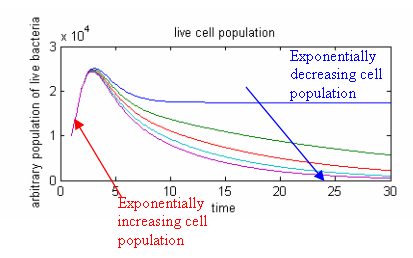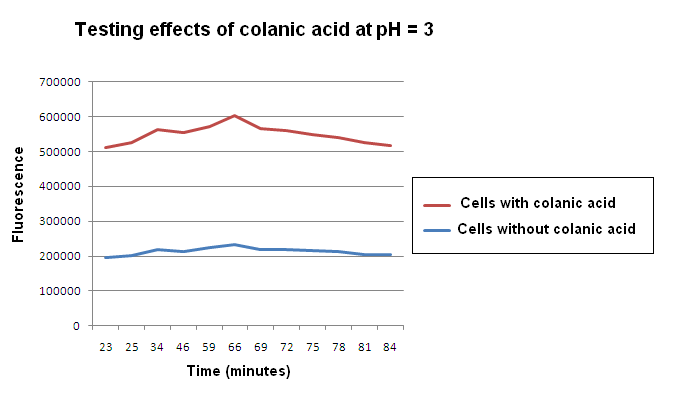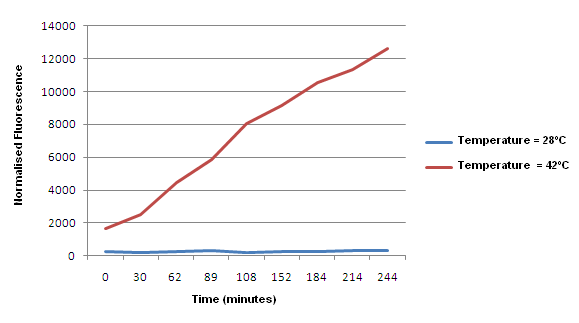Team:Imperial College London/Major results
From 2009.igem.org
(→Cell population model) |
(→Cell population model) |
||
| Line 34: | Line 34: | ||
==Cell population model== | ==Cell population model== | ||
| - | |||
| - | |||
| - | |||
[[Image:M3s.6.png | right]] | [[Image:M3s.6.png | right]] | ||
| + | Furthermore, the dry lab has provided a model on cell population under the production of restriction enzymes.<br> | ||
| + | <br> | ||
| - | We have shown that an increase in restriction enzyme concentration will cause a decrease total cell population, under the absence of Dam protection. | + | We have shown that an increase in restriction enzyme concentration will cause a decrease total cell population, under the absence of Dam protection. |
<br> | <br> | ||
<br> | <br> | ||
Revision as of 03:12, 22 October 2009

Contents |
Major Results
This page contains highlights of our major results and simulations. It is by no means complete. However, more results will be presented at the jamboree.
Genome Digestion Assay
- The wet lab has also investigated the effects of restriction enzymes on cell population.
In this assay, we performed a restriction digestion on Dam negative and Dam positive strains, using restriction enzymes DpnII and TaqI, to investigate their effects on the two strains.
Positive results were achieved.
From the gels above, we notice that there are 'smears'in the gels for the Dam negative strains. These 'smears'are created when the Dam negative strains are fully cleaved at all different concentrations of restriction enzyme.
From these results, we have shown that restriction enzymes can cleave Dam negative strains, hence killing Dam negative cells. This also proves Dam positive strains are protected again genomic deletion.
Cell population model
Furthermore, the dry lab has provided a model on cell population under the production of restriction enzymes.
We have shown that an increase in restriction enzyme concentration will cause a decrease total cell population, under the absence of Dam protection.
 About the results.
About the results.
Finding the Best Secondary Media for BBa_K200018
- Growth experiments on a secondary media were performed on the CRP promoter. From this experiment, we are able to choose the best secondary media for the optimal growth of cells.
From the graph on the right, we can see that the corrected fluorescence of glucose is almost negligible. Therefore, we have proved the theory that glucose represses the PcstA promoter strongly.
To determine the best secondary media, we note that 10% Casamino Acids in M9 media shows the highest corrected fluorescence as well as a high corrected OD600. This indicates good cell growth. No other media is comparable. Therefore, this is our secondary media of choice.
Diauxic Growth Models
We have implemented serval models for diauxic growth in order to characterize our autoinduction medium. More information about them can be found in the relevant pages in the dry lab hub.
 about autoinduction and diauxic growth models.
about autoinduction and diauxic growth models.
Encapsulation: Effect of pH on cells treated with colanic acid
In this experiment, we chemically induced the production of colanic acid. This relates to our Module 2: Encapsulation.
In a multiple well plate, 2 different types of cell cultures were grown, both containing the BBa_I13522 construct, a constitutive promoter expressing GFP.
- Growth rate of the cell cultures and levels of GFP expression were monitored over time, at different Ph values in order to decide if induction using colanic acid provides extra protection to the construct.
Conclusions:
- Cells treated with colanic acid grow slightly faster than non-treated cells.
- Fluorescence output is higher and lasts longer in cells treated with colanic acid.
Characterisation of BBa_K00022: Thermoinducible promoter
In this experiment, we want to investigate the behaviour of the lamda-cI thermoinducible promoter. Furthermore, this analysis serves to characterize the construct [http://partsregistry.org/wiki/index.php/Part:BBa_K200022 BBa_K200022], submitted by Harvard last year.
The characterization of the thermoinducible promoter is as follows:
- At 28°C, we cannot observe any fluorescence (GFP) output because its expression is repressed
- At 42°C, we can observe an increase in fluorescence (GFP) output, as its expression is no longer repressed
Hence, we can conclude that in The E.ncapsulator system, an increase in temperature de-represses the expression of downstream genes, which will trigger the genome deletion phase.
References
[1]Physica A: Statistical and Theoretical Physics, Vol. 188, No. 1-3. (1 September 1992), pp. 404-425. A rigorous derivation of the chemical master Equation
 "
"








